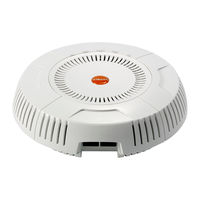Xirrus Wi-Fi Array XR4830 Manuals
Manuals and User Guides for Xirrus Wi-Fi Array XR4830. We have 2 Xirrus Wi-Fi Array XR4830 manuals available for free PDF download: User Manual
Xirrus Wi-Fi Array XR4830 User Manual (178 pages)
Wireless Arrays and Access Points.
XR Series;
XR-500 Series;
XR-600 Series;
XR-1000 Series;
XR-2000 Series;
XR-2005 Series;
XR-4000 Series;
XR-6000 Series
Brand: Xirrus
|
Category: Wireless Access Point
|
Size: 3 MB
Table of Contents
-
Introduction
23-
-
-
Fast Roaming39
-
-
Organization43
-
-
-
-
-
Placement52
-
RF Patterns53
-
-
Acexpress67
-
-
WDS Planning79
-
-
Logging in96
-
Licensing96
-
-
An Overview104
-
User Interface107
-
Logging in110
-
-
-
Array Summary114
-
Admin History122
-
-
-
Network123
-
Network Map124
-
ARP Table128
-
Routing Table128
-
DHCP Leases129
-
CDP Neighbors130
-
Undefined Vlans132
-
-
Iaps134
-
Channel History140
-
Radio Assurance142
-
-
-
Stations145
-
Location Map147
-
Rssi150
-
Noise Floor153
-
Max by IAP155
-
-
Wireless Array160
-
VLAN Statistics161
-
WDS Statistics162
-
IDS Statistics163
-
Vlans171
Advertisement
Xirrus Wi-Fi Array XR4830 User Manual (190 pages)
Brand: Xirrus
|
Category: Speaker System
|
Size: 4 MB
Table of Contents
-
Introduction
21-
-
-
Fast Roaming40
-
-
-
-
Placement82
-
RF Patterns83
-
-
Power Planning102
-
AC Power102
-
-
Wi-Fi Array102
-
-
Authentication103
-
WDS Planning110
-
-
-
-
An Overview134
-
User Interface137
-
Logging in141
-
-
-
-
Network150
-
Network Map151
-
ARP Table155
-
Routing Table155
-
DHCP Leases156
-
CDP Neighbors157
-
-
Stations168
-
Location Map169
-
Rssi173
-
Noise Floor177
-
Max by IAP179
-
-
-
VLAN Statistics184
-
WDS Statistics185

